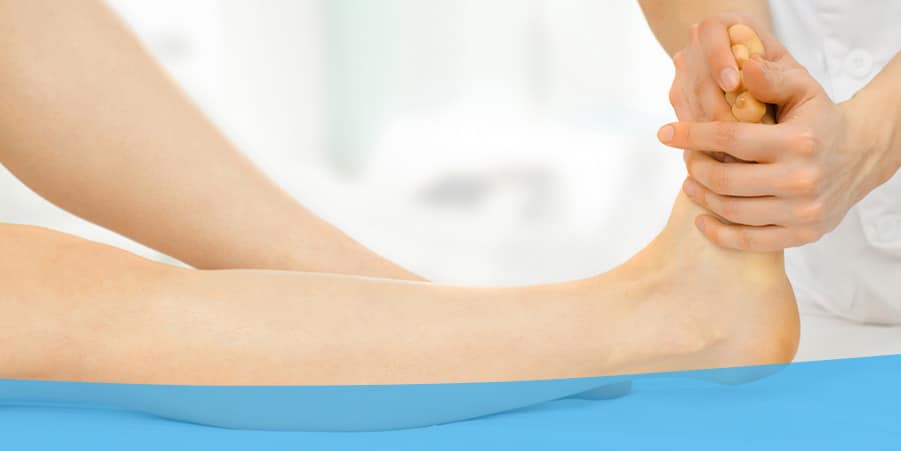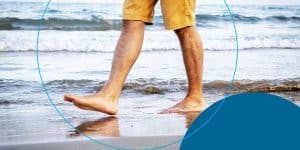Flat feet are a condition in which the feet have no arches and press flat onto the ground when standing. This can cause pain around the ankle or lower leg and achiness on the inner side of the foot. While flat feet can make it difficult to walk or stand and get around comfortably, proper diagnosis, treatment and footwear can help you manage the discomfort and continue an active lifestyle.
Read on to learn more about the flat feet condition and its causes, as well as how to fix flat feet pain and find relief.
Causes and Symptoms of Flat Feet
Flat feet can be caused by genetics, injuries, age and medical conditions. Some people are born with flat feet and never develop arches, while others develop flat feet later in life. Risk factors for the condition can include obesity, diabetes and certain types of arthritis. Common symptoms of flat feet include:
- Foot pain: You might experience pain in the arch, heel or ankle that may worsen the longer you stand or do activities.
- Swelling: Swelling can often occur along the inside of the ankle.
- Changes in gait: You might notice changes in how you walk or run.
- Tired feet: Feet that feel tired or achy more often, especially after standing or walking, can be a sign of flat feet.
- Pain in the lower back, hips or knees: Pain in these areas often results from the increased strain placed on supporting muscles when you have no support from the feet.
Warning signs of flat feet can include trouble standing or walking for long periods, being unable to stand on your toes or pain that worsens with activities like running or walking.
Impact of Flat Feet on Lifestyle
Some people may have no symptoms from flat feet, living comfortably without any pain or changes in mobility. Others might have trouble getting around day to day or participating in sports and other activities. Flat feet can also make it hard to find shoes that fit and give the support you need to move around comfortably.
Treatment for Flat Feet
If flat feet are causing you pain or affecting your ability to walk and move around, treatment options like orthotics and physical therapy can help. Certain lifestyle adjustments can also help you manage the condition:
Exercises
A podiatrist can recommend certain exercises that help relieve flat feet symptoms or prevent flat feet from even developing. These focus on improving the strength and flexibility in your feet and ankles:
- Heel raises: Heel raises can prevent your Achilles tendon from tightening and protect your foot from rolling inward. To do a heel raise, stand with your feet flat and lift your heels. The exercise can strengthen the calf muscles, indirectly supporting the arch.
- Towel curls: This exercise involves sitting with a towel under your feet and using your toes to scrunch the towel. This helps strengthen the intrinsic foot muscles.
- Toe raises: Stand with your feet flat and raise your toes off the ground. This exercise engages the arch muscles.
- Calf stretches: Stand in front of a wall with one leg slightly behind the other and lean forward, feeling the stretch in your calf muscles.
Orthotics
If flat feet are causing pain and discomfort or are affecting your ability to get around, orthotics can be the perfect solution. They work by cushioning and adjusting how your foot absorbs shock or receives pressure from the ground. In this way, they reduce pain associated with flat feet and improve foot alignment.
You can opt for custom-made orthotic insoles or buy them over the counter to give you the arch support you need to walk and stand more comfortably. Just be sure that you use orthotics under a doctor’s supervision, as the wrong ones can worsen symptoms.
Lifestyle Modifications
Many easy lifestyle changes can enhance your comfort if you have flat feet:
- Low-impact activities: Avoid strenuous activities that could worsen your symptoms. For example, low-impact exercises like swimming, cycling and yoga can help you stay active while minimizing discomfort.
- Rest: Be sure to rest your feet every day, especially after you’ve been on them for a long time. This can relieve aches and keep the condition from worsening.
- Ankle braces: An ankle or foot brace can provide support by absorbing the pressure on the tendons, helping ease pain associated with flat feet.
Other Tips for Living With Flat Feet
Aside from exercise and orthotics, certain lifestyle tips and changes can help you experience less pain with flat feet:
- Maintain a healthy weight: If obesity is a contributing factor to your flat feet, exercising and eating a nutritious diet can help you reach a healthier body mass index and reduce stress on your arches.
- Integrate the right exercises: To stay active with flat feet, focus on strengthening exercises, calf stretches and low-impact activities like yoga, swimming and cycling. These can improve your flexibility while reducing stress on the feet.
- Choose the right shoes: Make sure you choose shoes that will properly support your feet and keep you stable. They should have arch support, firm but cushioned soles and a wide toe box.
If you are an athlete with flat feet, make sure you do exercises that strengthen your foot and ankle muscles. You should also choose supportive shoes or orthotics for added stability and seek guidance from a podiatrist for treatment options.
FAQs and Next Steps
Here are answers to some of the most common questions asked about flat feet:
1. Can You Fix Flat Feet?
Flat feet can be managed and sometimes even corrected. However, treatment is often more about managing symptoms rather than “fixing” them. For instance, orthotics for flat feet can be inserted into your shoe to help distribute weight evenly and alleviate foot and ankle stress or discomfort.
In rare cases, surgery could be an option if other treatments don’t work or if flat feet are causing severe pain or mobility issues.
2. What’s the Best Thing to Do for Flat Feet?
The best approach for flat feet depends on your symptoms and severity. For mild cases, lifestyle changes like doing low-impact exercises and wearing supportive footwear can enhance your comfort. For more severe cases, physical therapy and orthotics may help improve strength in the feet, ankles and calves to reduce pain.
3. How Do Flat Feet Affect Daily Life?
Flat feet can affect daily life by impacting balance, stability and the body’s alignment, leading to more fatigue, pain and risk of injuries. It can cause discomfort when standing, walking or running, even affecting the exercises or activities you’re capable of completing in your day-to-day life.
4. When Should You See a Specialist?
Consider seeing a specialist, like a podiatrist, for flat feet if yours are causing pain, limiting your daily activities or come with swelling, difficulty walking or aches in other areas of your body. While flat feet are usually painless and don’t always require treatment, if you have a lot of pain in the arch or heel, a podiatrist can diagnose and help treat your symptoms.
Seek Professional Advice from Foot & Ankle Surgical Associates
Flat feet are a common condition that can cause mobility challenges or discomfort. Thankfully, certain treatments can help you manage the condition so it doesn’t get in the way of your active lifestyle. At Foot & Ankle Surgical Associates, our skilled podiatry team can treat any foot disorder, from mild to severe. Our goal is to get you back on your feet so you can enjoy life with ease.
Call us at 360-754-3338 to discuss any foot issue you may be having, or fill out a contact form, and we’ll get in touch to arrange an appointment.
Linked sources:
- https://fasafw.com/blog/common-foot-problems-in-older-adults/
- https://www.healthline.com/health/flat-feet-exercises#heel-stretches
- https://fasafw.com/blog/orthotics-for-flat-feet/
- https://fasafw.com/podiatry/
- https://www.sciencedirect.com/science/article/pii/S2773157X23001224
- https://fasafw.com/about/podiatry-team/
- https://fasafw.com/#email-form





